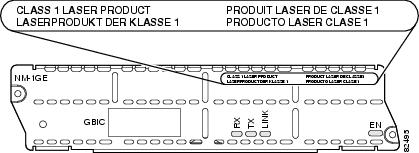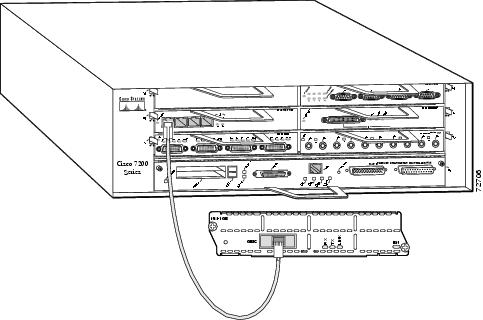Gigabit Ethernet Network Modules
Available Languages
Table Of Contents
Connecting Cisco Gigabit Ethernet Network Modules to the Network
Gigabit Ethernet Network Modules
Connecting Gigabit Ethernet Network Modules to the Network
Gigabit Ethernet Network Module LEDs
Obtaining Documentation, Obtaining Support, and Security Guidelines
Connecting Cisco Gigabit Ethernet Network Modules to the Network
Revised: May 1, 2008, OL-12825-01
This guide describes how to connect Cisco Gigabit Ethernet network modules to your network. It contains the following sections:
•
Gigabit Ethernet Network Modules
•
Gigabit Ethernet Network Module LEDs
•
Obtaining Documentation, Obtaining Support, and Security Guidelines
Gigabit Ethernet Network Modules
The Gigabit Ethernet network module provides single-port Gigabit Ethernet connectivity through an installed Gigabit interface converter (GBIC). The GBIC determines the type of connectivity available to the network module. (See Figure 1.)
Figure 1 Gigabit Ethernet Network Module Faceplate

See Table 1 for information on connection types supported by each GBIC.

Note
1000BASE-T ports cannot be looped back through use of an external loopback cable.
Table 1 Gigabit Ethernet Connection and Cable Types Supported on Gigabit Ethernet Network Modules
GBIC-ZX=
Extended distance 1000BASE-ZX
10-micron SMF cable (yellow) with SC connectors1
GBIC-LX/LH=
Long-wavelength or long-haul 1000BASE-LX/LH
10-micron SMF cable (yellow) with SC connectors1
TipIf using an MMF cable, install a mode-conditioning patch cord (CAB-GELX-625).
GBIC-SX=
Short-wavelength 1000BASE-SX
62.5-micron MMF cable (orange) with SC connectors
GBIC-T=
UTP Category 5 or 6 1000BASE-T
Category 5 or 6 UTP cable with RJ-45 connectors
CWDM-GBIC-1470=
1000BASE-CWDM GBIC 1470 nm
10-micron SMF cable (yellow) with SC connectors1
CWDM-GBIC-1490=
1000BASE-CWDM GBIC 1490 nm
10-micron SMF cable (yellow) with SC connectors1
CWDM-GBIC-1510=
1000BASE-CWDM GBIC 1510 nm
10-micron SMF cable (yellow) with SC connectors1
CWDM-GBIC-1530=
1000BASE-CWDM GBIC 1530 nm
10-micron SMF cable (yellow) with SC connectors1
CWDM-GBIC-1550=
1000BASE-CWDM GBIC 1550 nm
10-micron SMF cable (yellow) with SC connectors1
CWDM-GBIC-1570=
1000BASE-CWDM GBIC 1570 nm
10-micron SMF cable (yellow) with SC connectors1
CWDM-GBIC-1590=
1000BASE-CWDM GBIC 1590 nm
10-micron SMF cable (yellow) with SC connector1s
CWDM-GBIC-1610=
1000BASE-CWDM GBIC 1610 nm
10-micron SMF cable (yellow) with SC connectors1
1 10-dB SMF optical attenuators with SC connectors (two per duplex cable) are required for distances less than 25 km (15.5 miles). Install the attenuators between the male SC connector on the cable and the female SC connector on the network module.
Installing and Removing GBICs
Gigabit Ethernet network modules support GBIC hot-swapping. To save time, do not power down the router and network module before installing or removing the GBIC.

Warning
Because invisible laser radiation may be emitted from the aperture of the port when no fiber cable is connected, avoid exposure to laser radiation and do not stare into open apertures. Statement 240

Note
GBICs from other vendors are not supported by the Cisco Gigabit Ethernet network module.
Step 1
Hold down the clips on the side of the GBIC while inserting the GBIC into the GBIC slot in the network module faceplate. (See Figure 2.)
Figure 2 Installing a GBIC into a Network Module

Step 2
Release the side clips on the GBIC.
Step 3
Connect the Gigabit Ethernet network module to the network. (See Figure 4.) If installing the GBIC in an uninstalled network module, install the network module before connecting the network module to the network.
Laser Safety Guidelines
Optical GBICs use a small laser to generate the fiber-optic signal. Keep the transmit port covered whenever a cable is not connected to the port.
The module faceplate carries a Class 1 laser warning label. (See Figure 3.)
Figure 3 Class 1 Laser Warning Label


Warning
Because invisible laser radiation may be emitted from the aperture of the port when no fiber cable is connected, avoid exposure to laser radiation and do not stare into open apertures. Statement 240

Warning
Ultimate disposal of this product should be handled according to all national laws and regulations. Statement 1040
Connecting Gigabit Ethernet Network Modules to the Network

Warning
Because invisible laser radiation may be emitted from the aperture of the port when no fiber cable is connected, avoid exposure to laser radiation and do not stare into open apertures. Statement 240
Use the cables listed in Table 1 to connect the GBIC connectors on the network module to a networking device. (See Figure 4.)
Figure 4 Connecting a Gigabit Ethernet Network Module to a Cisco 7200 Series Router

Gigabit Ethernet Network Module LEDs
All network modules have an enable (EN) LED. This LED indicates that the module has passed its self-tests and is available to the router. See Figure 5 and Table 2 for LEDs specific to the Gigabit Ethernet network module.
Figure 5 Gigabit Ethernet Network Module LEDs

Related Documents
For additional information, see the following documents and resources.
CWDM passive optical system documentation
Cisco 1000BASE-CWDM Series Passive Optical System Installation Note
http://www.cisco.com/en/US/products/hw/modules/ps4999/prod_module_installation_guide09186a0080161813.htmlRegulatory compliance and safety information
Cisco Network Modules and Interface Cards Regulatory Compliance and Safety Information
http://www.cisco.com/en/US/docs/routers/access/interfaces/rcsi/IOHrcsi.htmlCisco IOS software website and reference documentation
Cisco IOS Software http://www.cisco.com/web/psa/products/index.html?c=268438303
Obtaining Documentation, Obtaining Support, and Security Guidelines
For information on obtaining documentation, obtaining support, providing documentation feedback, security guidelines, and also recommended aliases and general Cisco documents, see the monthly What's New in Cisco Product Documentation, which also lists all new and revised Cisco technical documentation, at:
http://www.cisco.com/en/US/docs/general/whatsnew/whatsnew.html
CCDE, CCENT, Cisco Eos, Cisco Lumin, Cisco StadiumVision, the Cisco logo, DCE, and Welcome to the Human Network are trademarks; Changing the Way We Work, Live, Play, and Learn is a service mark; and Access Registrar, Aironet, AsyncOS, Bringing the Meeting To You, Catalyst, CCDA, CCDP, CCIE, CCIP, CCNA, CCNP, CCSP, CCVP, Cisco, the Cisco Certified Internetwork Expert logo, Cisco IOS, Cisco Press, Cisco Systems, Cisco Systems Capital, the Cisco Systems logo, Cisco Unity, Collaboration Without Limitation, EtherFast, EtherSwitch, Event Center, Fast Step, Follow Me Browsing, FormShare, GigaDrive, HomeLink, Internet Quotient, IOS, iPhone, iQ Expertise, the iQ logo, iQ Net Readiness Scorecard, iQuick Study, IronPort, the IronPort logo, LightStream, Linksys, MediaTone, MeetingPlace, MGX, Networkers, Networking Academy, Network Registrar, PCNow, PIX, PowerPanels, ProConnect, ScriptShare, SenderBase, SMARTnet, Spectrum Expert, StackWise, The Fastest Way to Increase Your Internet Quotient, TransPath, WebEx, and the WebEx logo are registered trademarks of Cisco Systems, Inc. and/or its affiliates in the United States and certain other countries.
All other trademarks mentioned in this document or Website are the property of their respective owners. The use of the word partner does not imply a partnership relationship between Cisco and any other company. (0804R)
Any Internet Protocol (IP) addresses used in this document are not intended to be actual addresses. Any examples, command display output, and figures included in the document are shown for illustrative purposes only. Any use of actual IP addresses in illustrative content is unintentional and coincidental.
© 2008 Cisco Systems, Inc. All rights reserved.
Contact Cisco
- Open a Support Case

- (Requires a Cisco Service Contract)
 Feedback
Feedback